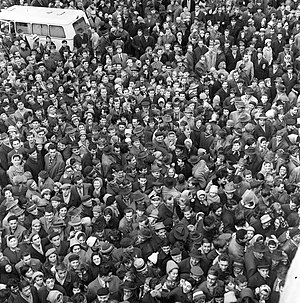First Congress of Nagymező
| First Congress of Nagymező 1929 Congress of Nagymező | |
|---|---|
 Crowd gather outside of the Hall of Esteemed Vezprémics | |
| Host country | |
| Cities | Nagymező |
| Participants | |
| Chair | Joint chair shared by Zoltán Somogyi and Fidél Égető |
| Precedes | Second Congress of Nagymező |
The First Congress of Nagymező, known simply as the 1929 Congress of Nagymező was a diplomatic conference that was hosted in effort to conclude hostilities in the Citizenry Uprising before the Battle of Csongrád and the following Petition of Ándrassy that was signed by all members of the Országgyűlés, and afterwards was signed by the Cabinet of National Citizens in conjunction with the Strategic Council of the National Militia. The meeting was held in four weeks in the city of Nagymező and was chaired by two elected representatives that each side would elect, Országgyűlésarian Nemesség Zoltán Somogyi and Polgárság Governor of the Western Nationalist Government Fidél Égető. The Congress was held between October 20 to November 17, when the Armistice of Nagymező was signed in effect by both the Second Noble Republic of Hétumoger and the Citizens Republic of Hétumoger. The First Congress was attended by the Messidor Union.
The main objective of the First Congress that was defined in the Csongrád Peace Agreement was to come to a full agreement that will allow both countries to fully disengage in hostilities. The war had became extremely unpopular in the Second Noble Republic due to deteriorating economic conditions due to a lack of labor force that was addressed in the Petition of Ándrassy, where all Parlimentarians signed to end the war. The Csongrád Peace Agreement was an agreement presented and signed by the Four Vanguards in an effort to pause the war and agree to create the framework of a peace plan between the divided states within Hétumoger. The First Congress was given a timelimit that was defined by the Peace Agreement, in that both countries would have to assemble a cabinet of representatives to send to Nagymező in a week. Afterwards, the representatives would have a month within Nagymező to draft and agree to a document relating to the ceasefire or ending of the Citizenry Uprising. And if not, then the First Congress would be dissolved and the Peace Agreement would be annulled. In the leadup to First Congress, the Sió Indigeneous Revolt was underway, with the Noble Republic on the offensive but unable to break through the Western Nationalist Militia without suffering heavy casualties, leading to a stalemate.
The First Congress held a total of ten plenary sessions that culminated in the drafting of the armistice in the fourth plenary session and the signing in the tenth plenary session. During the assembly of the representatives, the Battle of Csongrád began due to the Western Nationalist Militia not having recieved proper communications beforehand. It was assumed that the First Congress would be postponed, but the Cabinet of National Citizens requested the Strategic Council to hold soldiers that were engaged in Csongrád in order to preserve the Peace Agreement. The First Conress was organized into several blocs by their allegiance and position in the Citizenry Uprising and their respective governments.
Partipating Members
| Noble Republic Képviselőtanács |
Noble Országgyűlési Képviselők |
Blue Nationalist Congress |
Citizens Government Representatives |
National Militia Representative Council |
Foreign Overseer Council |
|---|---|---|---|---|---|